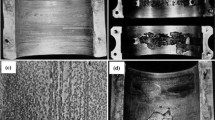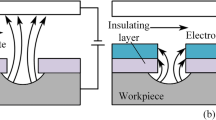Abstract
Hydrodynamic bearing is becoming an indispensable component of high-accuracy devices such as high-speed machine tools. Recently, the study of textured surface bearing has become one of the highly researched topics. Among the different types of surface texture, partially textured bearing shows outstanding performances on anti-vibration. However, most of the research focuses on the theoretical models of partial texture. In this paper, several bearings with no texture, full texture and partial texture are fabricated for stability and stiffness tests. The result shows that the partially textured bearings with 60% of textured ratio and 4.9% of area ratio exhibit the best properties, which could decrease the maximum amplitude by 45.8% at 9000 rpm. In addition, the textured surface with the optimal textured ratio of 60% can reduce the static stiffness and improve the dynamic stiffness. Therefore, partially textured bearings are particularly significant to the stability enhancement of the bearing system, which can lead to the performance and security improvement of the sliding bearing in high-speed applications.










Similar content being viewed by others
Data availability
Available.
Code availability
Not applicable.
References
Kango S, Singh D, Sharma RK (2012) Numerical investigation on the influence of surface texture on the performance of hydrodynamic journal bearing. Meccanica 47(2):469–482
Wang SH, Wu XY, Zheng JH (2011) Influence of surface texture on lubrication performance of hydrodynamic journal bearing. Appl Mech Mater 120:426–431
Meng FM, Shu RH, Chen L (2020) Influences of operation parameters on noise of journal bearing with compound texture considering lubricant thermal effect. Proceedings of the Institution of Mechanical Engineers, Part J: Journal of Engineering Tribology 234(7):991–1006
Yu RF, Chen W, Li P (2016) The analysis of elastohydrodynamic lubrication in the textured journal bearing. Proceedings of the Institution of Mechanical Engineers, Part J: Journal of Engineering Tribology 230(10):1197–1208
Feng HH, Peng LP (2018) Numerical analysis of water-lubricated thrust bearing with groove texture considering turbulence and cavitation. Industrial Lubrication and Tribology 70(6):1127–1136
Rao TVVLN, Rani AMA, Nagarajan T, Hashim FM (2013) Load capacity of partially textured journal bearing with trapezoidal recess. Appl Mech Mater 315:830–834
Wang J, Zhang JH, Lin JW, Ma L (2018) Study on lubrication performance of journal bearing with multiple texture distributions. Appl Sci 8(2):244
Xie ZL, Zhang Y, Zhou JZ, Zhu WD (2021) Theoretical and experimental research on the micro interface lubrication regime of water lubricated bearing. Mechanical Systems and Signal Processing 151: 107422.
Meng FM, Zhang W (2018) Effects of compound groove texture on noise of journal bearing. Journal of Tribology 140(3): 031703.
Teo WJ, Dolatabadi N, Rahmani R, Morris N, Rahnejat H (2018) Combined analytical and experimental evaluation of frictional performance of lubricated untextured and partially textured sliders. Lubricants 6(4):88–88
Etsion I, Halperin G (2002) A laser surface textured hydrostatic mechanical seal. Tribol Trans 45(3):430–434
Etsion I (2004) Improving tribological performance of mechanical components by laser surface texturing. Tribol Lett 17(4):733–737
Brizmer V, Kligerman Y, Etsion I (2003) A laser surface textured parallel thrust bearing. Tribol Trans 46(3):397–403
Etsion I, Burstein L (2008) A model for mechanical seals with regular microsurface structure. Taylor & Francis Group 39(3):677–683
Tala-Ighil N, Fillon M (2017) Performance evolution of fully and partially textured hydrodynamic journal bearings lubricated with two lubricants. IOP Conference Series: Materials Science and Engineering 174(1): 012032.
Song XT, Wu W (2020) The effect of journal misalignment on the lubrication performance of partially textured journal bearing with elastic deformation. Journal of Physics: Conference Series 1549(3): 032070.
Rao TVVLN, Rani AMA, Nagarajan T, Hashim FM (2012) Analysis of slider and journal bearing using partially textured slip surface. Tribol Int 56:121–128
Rao TVVLN, Rani AMA, Nagarajan T, Hashim FM (2014) Analysis of couple stress fluid lubricated partially textured slip slider and journal bearing using narrow groove theory. Tribol Int 69:1–9
Tauviqirrahman M, MuchammadJamari ARA (2018) Influence of boundary slip layout on the hydrodynamic performance of partially textured journal bearing by CFD method. MATEC Web of Conferences 204:04008
Rahmani R, Rahnejat H (2018) Enhanced performance of optimised partially textured load bearing surfaces. Tribol Int 117:272–282
Tomar AK, Sharma SC (2020) An investigation into surface texture effect on hole-entry hybrid spherical journal bearing performance. Tribology International 151:106417
Tomar AK, Sharma SC (2020) A study of hole entry grooved surface hybrid spherical journal bearing operating with electrorheological lubricant. Journal of Tribology 142(11):111802
Hao XQ, Sun HL, Wang L, Ali Q, Li L, He N (2020) Fabrication of micro-texture on cylindrical inner surface and its effect on the stability of hybrid bearing. Int J Adv Manuf Technol 109:1671–1680
Kligerman Y, Etsion I, Shinkarenko A (2005) Improving tribological performance of piston rings by partial surface texturing. Transactions of the ASME Journal of Tribology 127(3):632–638
Ryk G, Etsion I (2006) Testing piston rings with partial laser surface texturing for friction reduction. Wear 261(7–8):792–796
Funding
The authors greatly acknowledge the financial support from the National Natural Science Foundation of China (51875285), the Natural Science Foundation of Jiangsu Province (BK20190066), the College Young Teachers Fund of the Fok Ying Tung Education Foundation (20193218210002), the Fundamental Research Funds for the Central Universities (NE2020005), and the State Key Laboratory of Mechanical System and Vibration (MSV202008).
Author information
Authors and Affiliations
Corresponding author
Ethics declarations
Ethics approval
Approval.
Consent to participate
Approval.
Consent for publication
Approval.
Conflict of interest
The authors declare no competing interests.
Additional information
Publisher's note
Springer Nature remains neutral with regard to jurisdictional claims in published maps and institutional affiliations.
Rights and permissions
About this article
Cite this article
Niu, Y., Hao, X., Xia, A. et al. Effects of textured surfaces on the properties of hydrodynamic bearing. Int J Adv Manuf Technol 118, 1589–1596 (2022). https://doi.org/10.1007/s00170-021-08022-1
Received:
Accepted:
Published:
Issue Date:
DOI: https://doi.org/10.1007/s00170-021-08022-1




